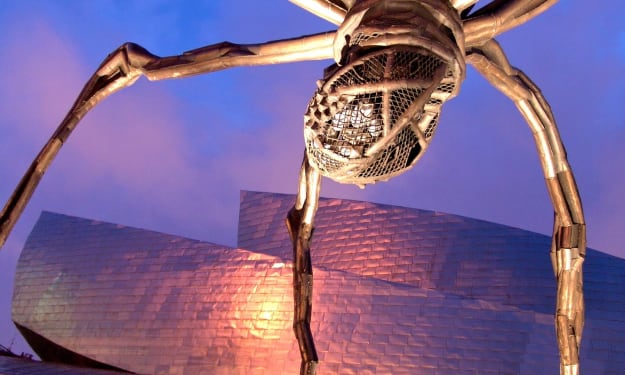Critical Mass
There are things we're not meant to know. And those are the interesting things.

Everyone has at least seen a fire; everyone can visualize an explosion. When the Earth’s most powerful minds were corralled at Los Alamos to kindle a dark star in the desert, they all knew roughly what they were hoping and dreading to see. White light; black flame. But breaking matter into energy was only half the equation.
Easterly, the horizontal greyness yielded slowly to a dead yellow gloom like the buzz of an old fluorescent. Reluctant day metastasized across the Badlands; a few bleak snowflakes hung in the gibbet of the bitter air. Harsh chemical smoke escaped from a number of Dr. Valmont’s facial orifi as he flicked the red end of his cigarette from the walkway into the vast brown carrionscape below.
“Seriously, Valmont, who smokes anymore?”
He turned laconically to face his colleague, Dr. Calloway: a tall, slim American woman with a face just a trifle too shrewd to be pretty. Not that his oft-broken nose left him much room to critique the physiognomies of others. “Old British professors marooned in the colonies,” he said.
Calloway ambled over and leaned against the railing, the mist of her own breath faintly visible. The sun rose swiftly; far off, at the edge of vision, one could just make out the glint of Devil’s Lake.
“Where do you even get those things?” she asked idly.
“Oh, I found an old cigarette machine in one of the sub-basements. I may have—eased open the glass.”
“Bloody hoodlum. But for pity’s sake, they must have expired years ago!”
“Back around the time I was boxing my way to a bachelor’s degree, by my calculations. Still, better than nothing, you know.”
“Oh gee, did you box at Oxford? You’ve never mentioned that in the past few hours.”
A new voice, earnest and deep: “My friends.”
They both turned to greet Dr. Ilibizaga, a man big enough to be a linebacker, but so meditatively quiet that he never seemed to take up any space.
“Our guest is waking up,” he said gravely.
“Shake a leg, Valmont!”
The three physicists hastened down the stairs to the elevator. Each occupant peered impatiently into the retinal scanner and punched in a personal code; the small, cold box plummeted through forsaken tectonic depths; and each of them was scanned and coded again before the heavy steel door hissed open.
Beyond the door was a corridor. Chilly, white, and sterile, it stretched like an old dead maggot from the elevator to the distant door of their lab. Along the way were other doors, none of them bearing words or names, identified by esoteric symbols comprehensible only to the researchers working on each individual project—and, presumably, to the shade-veiled intellects overseeing the cryptic laboratories of Delving Industries.
At the end of the hall was another nondescriptly impregnable door. The marking on this one was simple:
m=e/c^2
Here they plied their impossible trade, straining the nascent science of Numinometrics, battering the inner walls of the outer limits.
The bright, antiseptic chamber of stainless steel, lit with gelid LEDs, housed well over $200 million worth of gen-after-next technology. Desks and tables lined the walls, leaving the central space uncluttered; large, fibrous arrays of probes and sensors, quivering like nine-foot-long spider-legs, clustered around the translucent circular column in the middle of the room.
“We’re extremely sure it can’t get out?” Calloway said tightly.
Ilibizaga nodded, Zen-calm. “Nor can it see us.”
L1, the figure on the cot, was stirring—muttering. Valmont drew his flask and gulped some bourbon. Ilibizaga quintuple-checked the recording equipment. Calloway held her breath.
The figure sat up.
Inside the column, the air was warm and the light soft. The encircling wall, opaque, was a soothing mauve. Pure oxygen was being circulated. None of these atmospherics palliated L1’s yellow glare.
The L stood for Lykomorph. Of course they couldn’t just use the word that everyone knew, Valmont reflected mordantly; one wanted a bit of neologistic jargon, to reduce the thing.
“Kto ty?” Broken glass, that voice. “Chto ty khochesh?” The fists clenched, knuckles crunching like dead leaves. “Ya tebya ub’yu.” Slowly, L1 rose.
“Here we go,” Calloway said, and tapped a button.
Inside the column, the light became a hard, flashing red. The floor began to rattle erratically. The temperature spiked, ammonia came through the ventilation, and a grinding, deafening klaxon blared.
Both sides wanted them. They were strong, they were fast, they could bite through metal; they viewed conventional weapons with malevolent mirth; and their brutal temperament, though not without its administrative challenges, was perfect for shock troops, as long as one kept them pointed at the enemy. Even an idiot could see their military value—but Delving Industries did not employ idiots. And if their math was right, the Lykomorphs contained something far more valuable.
It was happening. L1’s body contorted horribly—began to rock and split. The drab, tidy uniform shredded at the seams, abruptly overflowing with fur. Muscles like bridge cables bulged and coiled; nails lengthened, ripping out from flesh, curving into claws. L1’s mouth stretched like a hideous nightmare mask, giving freakish birth to jaws that snapped and slavered and finally issued the bone-shaking howl of accursed antediluvian myth. The scientists cowered and slapped their hands over their ears.
Huge, deformed, bipedal, it loomed in the epileptic light. A stomp crushed the cot. A flurry of slashes covered the wall in curves and loops, claw-scrawled geometrics, a lunatic roadmap to Hell. When these scratches on the transtitanium nanocage repaired themselves, the creature went truly berserk.
“Jesus Christ,” Valmont whispered.
They’d all seen footage—dozens of hours of it. And the longer the rampage continued, the clearer it became that the containment would hold. And furthermore, the slightest hint of breach would bring a team sprinting in with photon tasers and gravitonic hypermesh deployers. None of that, however, addressed the primordial fear of beholding a thing both subhuman and supernatural, a thing not meant by Heaven, a thing that must not be.
An undeniable underpinning of the universe: an object cannot change its mass. Its weight, certainly, that was easy, stand on a denser planet and you weigh more, a lighter one and you weigh less. But mass, the amount of matter an object was composed of—by definition, the only way to alter that was to physically add or remove matter. A = A. QED.
And yet, the God-damned werewolves.
As expected, the Numinometers were lit up like pinball machines. Lykomorphosis added around 100 kilograms to the body mass, which equaled around 2,150 megatons of raw energy, which in turn equaled around 45 Tsar hydrogen bombs. The question now was twofold: where did the energy come from, and how could it be harnessed?
At last, L1’s terrifying rage was spent. The column’s interior was now painted with clumps of blood and fur from the monster smashing itself against the cage over and over again; both wall and wolf were already healing. Slowly, crookedly, the abomination folded and cracked itself back into human form. L1 dropped to the floor, cross-legged, and closed aer eyes.
Preliminary data sheets were sliding into the printer tray. Calloway picked them up and straightened them with hands that visibly shook. “Come on, let’s get some air.”
They headed back up to the walkway. Valmont lit a cigarette, drank from his flask, then let the smoke sigh out of his alveoli. Wordlessly, his friends extended supplicating hands—Calloway for a smoke, Ilibizaga for a drink.
After a smallish sip, the big Kenyan perused the data while the others leaned and puffed. The ring in their ears from the bedlam downstairs was eerily absorbed by the monumental silence, a sea on which drifted the crinkle of paper and the groaning of the frigid wind.
Then: “It is not possible!”
Calloway glanced up. “Whattaya got, Thomas?”
“The energy, it comes through a quantum tunnel.”
“Okay? That corroborates our best hypothesis.”
“But look.” He brandished the papers with uncharacteristic violence. They looked.
A long pause.
Halting, unwilling, Calloway said, “If this is right. . .”
She trailed off, and Valmont finished: “The tunnel’s length is infinite. It’s at right angles to the whole of existence. The whole of reality.”
“So—” she gestured aimlessly “—what does that mean?”
“We must stop our research,” Ilibizaga said grimly. “At once.”
“Now hang on a moment,” Valmont spluttered.
“Edward, no. This is not the Manhattan Project. What is at stake is not a city, nor an island, but everlasting damnation for every human soul.”
“You don’t know that! We don’t know anything yet. It could be a portal to bloody Rivendell for the evidence we’ve got. Besides, if the Sinos aren’t already working on this same technology, they soon will be.”
“Then Sinorussia will have its own choice to make. I hope they are wiser than we.”
“Guys.” Calloway held up her hands. “Take a breath. We’re all good guys here.”
“All right, listen,” Valmont said, moderating his tone. “Every once in a great while, we suss out something important. You can hit harder and lift more if you’ve got a tool. If you put a seed in the ground, it turns into food. Fuse some nuclei and you can blow things up. It’s all very impressive to the other primates, I’m sure, but ask the universe if it’s intimidated. The sun’s been fusing atoms all along. The planet’s been growing food all along. Tools? The cosmos has electromagnetism, I doubt it’s flabbergasted by the pulley.”
“What’s your point, Valmont?”
“My point is, this is different. We’re not learning to harness a natural process, we’re transcending the natural order altogether. This is us getting a leg up on the universe for the first time since time began.”
Ilibizaga said quietly, “I do not think of the universe as my enemy.”
“Yet you assume that a tunnel leads to Beelzebub when it could just as well lead to Buddha.”
“. . . Very well. Perhaps it is better to seek truth, whatever the price.”
“Agreed,” said Calloway. “Also, I’m crazy curious now.”
Together, they returned to the lab and found L1 in two pieces.
No one spoke. The Lykomorph lay steaming, partially transformed. The wolven hands were red. The human face, several feet away, was fixed in a final yowl of misery and pain. One of the feet still twitched.
“We did this.” Calloway’s face was pale as the whites of her eyes, the pupils like coals in snow. “How could we do this?”
“We had no choice,” Valmont muttered.
“We did,” Ilibizaga said. “We do.”
There was a ding from the computer: 0800 hours, time for their daily status update to HQ. When Delving learned, they would send a collection team for another specimen.
“They’ll just get someone else if we quit,” said Valmont.
Calloway, almost inaudibly: “I don’t want to quit.”
The wall clock, beyond the twisted headless body, clicked to 8:01. The computer dinged again.
About the Creator
J.B. Toner
J.B. Toner studied Literature at Thomas More College, holds a black belt in Kenpo-Jujitsu, and struggles with level one autism. He has published two novels, Whisper Music and The Shoreless Sea. Toner lives and works in Massachusetts.






Comments
There are no comments for this story
Be the first to respond and start the conversation.